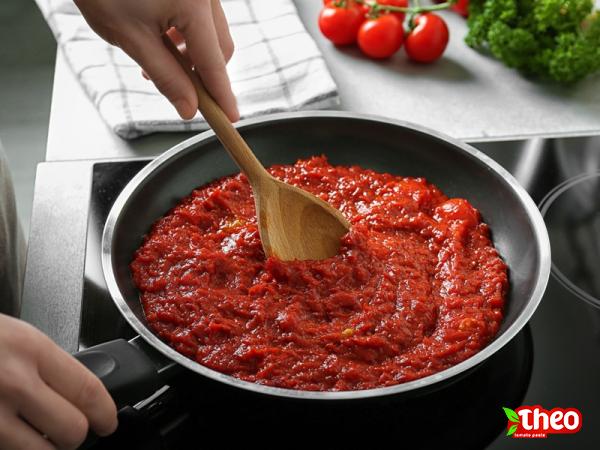A tomato-based sauce is a versatile and popular condiment that can be used in a wide range of recipes. However, sometimes it may be necessary to thicken a tomato-based sauce to enhance its texture and consistency. Thickening a tomato-based sauce not only improves its mouthfeel but also helps it adhere better to the accompanying food. There are several methods for thickening tomato-based sauces, each with its own benefits and drawbacks. These methods include reducing the sauce, using a roux or a slurry, adding a thickening agent, or incorporating ingredients that naturally thicken the sauce. The choice of method depends on personal preference, dietary restrictions, and the desired outcome. Reducing the Sauce: One of the simplest ways to thicken a tomato-based sauce is by reducing it through simmering. This involves cooking the sauce over low heat for an extended period, allowing the liquid to evaporate and the flavors to concentrate. Reducing the sauce not only thickens it but also intensifies its taste. However, this method can take time, and there is a risk of overcooking the sauce if not monitored closely.

tomato paste
 Using a Roux: Another common method for thickening tomato-based sauces is by using a roux, which is a mixture of equal parts fat and flour. The fat, usually butter or oil, is heated in a saucepan, and the flour is added gradually, creating a thick paste. The roux is then added to the sauce, which thickens as the starch in the flour absorbs the excess liquid. The advantage of using a roux is that it adds richness and depth of flavor to the sauce. However, it may alter the taste and color of the sauce, and it is not suitable for those following a gluten-free diet. Using a Slurry: Similar to a roux, a slurry is a mixture of liquid and a thickening agent that can be used to thicken tomato-based sauces. Cornstarch is a commonly used thickening agent when making a slurry. To create a slurry, cornstarch is mixed with cold water or broth until it forms a smooth paste. The slurry is then added to the sauce and cooked over low heat until it thickens. The advantage of using a slurry is that it is a gluten-free option and does not alter the taste or color of the sauce. However, it can sometimes result in a slightly gelatinous texture if not used in moderation. Adding a Thickening Agent: Another approach to thickening tomato-based sauces is by adding a thickening agent directly to the sauce. A variety of commercially available thickening agents can be used, such as tomato paste, tomato puree, or tomato sauce. These ingredients not only thicken the sauce but also enhance its tomato flavor. Simply adding a small amount of any of these options and cooking the sauce for a few minutes can result in a thicker consistency. The advantage of using a thickening agent is its convenience and minimal effort required. However, it is essential to use them sparingly to preserve the balance of flavors in the sauce. Incorporating Natural Thickeners: Lastly, it is also possible to thicken tomato-based sauces by incorporating ingredients that naturally have thickening properties. Vegetables such as onions, carrots, or mushrooms can be sautéed and then pureed before adding them to the sauce. The natural starches present in these vegetables help thicken the sauce while adding flavor and nutrients. Another natural thickener is grated Parmesan cheese, which can be sprinkled into the sauce and melted. This not only thickens the sauce but also adds a creamy and savory element. The advantage of using natural thickeners is that they contribute to the overall taste and nutritional value of the sauce. However, they may also alter the flavor profile of the sauce, so it is important to consider the desired outcome. In conclusion, there are several methods for thickening tomato-based sauces, each with its own benefits and drawbacks. Whether you choose to reduce the sauce, use a roux or a slurry, add a thickening agent, or incorporate natural thickeners, it is essential to consider the desired outcome, dietary restrictions, and personal preference. Experimenting with different methods will allow you to find the perfect balance of flavor, texture, and consistency for your tomato-based sauce.Title: Thicken Tomato-Based Sauce: Business Insights and Tips
Using a Roux: Another common method for thickening tomato-based sauces is by using a roux, which is a mixture of equal parts fat and flour. The fat, usually butter or oil, is heated in a saucepan, and the flour is added gradually, creating a thick paste. The roux is then added to the sauce, which thickens as the starch in the flour absorbs the excess liquid. The advantage of using a roux is that it adds richness and depth of flavor to the sauce. However, it may alter the taste and color of the sauce, and it is not suitable for those following a gluten-free diet. Using a Slurry: Similar to a roux, a slurry is a mixture of liquid and a thickening agent that can be used to thicken tomato-based sauces. Cornstarch is a commonly used thickening agent when making a slurry. To create a slurry, cornstarch is mixed with cold water or broth until it forms a smooth paste. The slurry is then added to the sauce and cooked over low heat until it thickens. The advantage of using a slurry is that it is a gluten-free option and does not alter the taste or color of the sauce. However, it can sometimes result in a slightly gelatinous texture if not used in moderation. Adding a Thickening Agent: Another approach to thickening tomato-based sauces is by adding a thickening agent directly to the sauce. A variety of commercially available thickening agents can be used, such as tomato paste, tomato puree, or tomato sauce. These ingredients not only thicken the sauce but also enhance its tomato flavor. Simply adding a small amount of any of these options and cooking the sauce for a few minutes can result in a thicker consistency. The advantage of using a thickening agent is its convenience and minimal effort required. However, it is essential to use them sparingly to preserve the balance of flavors in the sauce. Incorporating Natural Thickeners: Lastly, it is also possible to thicken tomato-based sauces by incorporating ingredients that naturally have thickening properties. Vegetables such as onions, carrots, or mushrooms can be sautéed and then pureed before adding them to the sauce. The natural starches present in these vegetables help thicken the sauce while adding flavor and nutrients. Another natural thickener is grated Parmesan cheese, which can be sprinkled into the sauce and melted. This not only thickens the sauce but also adds a creamy and savory element. The advantage of using natural thickeners is that they contribute to the overall taste and nutritional value of the sauce. However, they may also alter the flavor profile of the sauce, so it is important to consider the desired outcome. In conclusion, there are several methods for thickening tomato-based sauces, each with its own benefits and drawbacks. Whether you choose to reduce the sauce, use a roux or a slurry, add a thickening agent, or incorporate natural thickeners, it is essential to consider the desired outcome, dietary restrictions, and personal preference. Experimenting with different methods will allow you to find the perfect balance of flavor, texture, and consistency for your tomato-based sauce.Title: Thicken Tomato-Based Sauce: Business Insights and Tips
Specifications of tomato paste
 Introduction: Thickening a tomato-based sauce can be a crucial step in creating a satisfying and well-balanced culinary experience. While the process may seem straightforward, it presents unique business opportunities and challenges for professionals in the food industry. In this article, we will explore various aspects related to thickening tomato-based sauces, including market trends, product development, marketing strategies, and considerations for dietary preferences. 1. Market Trends and Consumer Demand: Understanding market trends and consumer preferences is vital for businesses involved in tomato-based sauce production. Currently, there is a growing demand for clean label ingredients, convenience products, and customized options. Consumers are seeking sauces that are free from artificial additives, preservatives, and excessive amounts of salt or sugar. They also desire products that offer ease of use and accommodate different dietary needs, such as gluten-free, vegan, or organic alternatives. 2. Product Development: Developing innovative and high-quality thickening options for tomato-based sauces can differentiate a brand in the market. This involves exploring various ingredients and formulations to achieve the desired texture and consistency. Companies can experiment with different thickening agents, such as vegetable purees, natural gums, or specialized blends, to meet specific customer requirements. Investing in research and development can lead to unique and attractive product offerings. 3. Flavor Enhancement: Thickening a tomato-based sauce should not compromise its flavor profile. Businesses should focus on maintaining the natural taste of tomatoes while ensuring the sauce adheres well to various dishes. Balancing acidity, sweetness, and umami notes is crucial to delivering a delightful culinary experience. Using high-quality tomatoes, herbs, and spices can enhance the overall flavor, creating a sauce that stands out in the market. 4. Packaging and Presentation: Effective packaging and presentation play a significant role in product differentiation and consumer appeal. Consider using transparent or glass containers to showcase the vibrant color and texture of thickened tomato-based sauces. Labels should clearly display key information, including ingredients, certifications, and dietary specifications. Consider using materials that are sustainable and eco-friendly to align with consumer values and contribute to a positive brand image.
Introduction: Thickening a tomato-based sauce can be a crucial step in creating a satisfying and well-balanced culinary experience. While the process may seem straightforward, it presents unique business opportunities and challenges for professionals in the food industry. In this article, we will explore various aspects related to thickening tomato-based sauces, including market trends, product development, marketing strategies, and considerations for dietary preferences. 1. Market Trends and Consumer Demand: Understanding market trends and consumer preferences is vital for businesses involved in tomato-based sauce production. Currently, there is a growing demand for clean label ingredients, convenience products, and customized options. Consumers are seeking sauces that are free from artificial additives, preservatives, and excessive amounts of salt or sugar. They also desire products that offer ease of use and accommodate different dietary needs, such as gluten-free, vegan, or organic alternatives. 2. Product Development: Developing innovative and high-quality thickening options for tomato-based sauces can differentiate a brand in the market. This involves exploring various ingredients and formulations to achieve the desired texture and consistency. Companies can experiment with different thickening agents, such as vegetable purees, natural gums, or specialized blends, to meet specific customer requirements. Investing in research and development can lead to unique and attractive product offerings. 3. Flavor Enhancement: Thickening a tomato-based sauce should not compromise its flavor profile. Businesses should focus on maintaining the natural taste of tomatoes while ensuring the sauce adheres well to various dishes. Balancing acidity, sweetness, and umami notes is crucial to delivering a delightful culinary experience. Using high-quality tomatoes, herbs, and spices can enhance the overall flavor, creating a sauce that stands out in the market. 4. Packaging and Presentation: Effective packaging and presentation play a significant role in product differentiation and consumer appeal. Consider using transparent or glass containers to showcase the vibrant color and texture of thickened tomato-based sauces. Labels should clearly display key information, including ingredients, certifications, and dietary specifications. Consider using materials that are sustainable and eco-friendly to align with consumer values and contribute to a positive brand image.
buy tomato paste
 5. Marketing Strategies: A strong marketing strategy is essential for promoting thickened tomato-based sauces and attracting a loyal customer base. Utilize both traditional and digital marketing methods to raise awareness and drive sales. Engage with consumers through social media platforms, recipe videos, and cooking blogs. Collaborate with influencers or chefs who can showcase the versatility of the sauce in various dishes. Additionally, participating in trade shows, food fairs, and local events can help create brand exposure and generate new business opportunities. 6. Catering to Dietary Preferences: Meeting the needs of diverse dietary preferences is crucial in today’s market. Offering gluten-free, vegan, and organic options can attract a wider customer base. Ensure that all ingredients used in the thickening process align with specific dietary guidelines and certifications. Clear labeling and transparent communication about allergens will instill confidence in consumers and encourage repeat purchases. 7. Cost Management: Effective cost management is crucial for businesses involved in thickening tomato-based sauces. Balancing ingredient costs, labor costs, and packaging expenses is necessary to ensure profitability. Careful sourcing of ingredients, streamlining production processes, and optimizing packaging can help minimize costs without compromising product quality. 8. Quality Control: Maintaining consistent quality is paramount for businesses operating in the food industry. Establishing stringent quality control measures throughout the manufacturing process is essential. Regular testing and analysis of samples, adherence to food safety regulations, and proper storage and handling practices are vital to ensure a high-quality and safe product. 9. Shelf Life and Storage: Understanding the shelf life and proper storage conditions of thickened tomato-based sauces is crucial for both manufacturers and retailers. Proper packaging, refrigeration, and temperature control are necessary to maintain product freshness and extend shelf life. Failure to consider these factors can result in spoilage, affecting both the taste and safety of the sauce. 10. Collaboration Opportunities: Exploring collaboration opportunities within the food industry can open new avenues for growth and innovation. Partnering with complementary businesses, such as pasta manufacturers, pizza parlors, or gourmet food stores, can result in mutually beneficial alliances. This can lead to cross-promotions, co-branded products, and shared marketing initiatives, amplifying the reach and impact of both businesses. Conclusion: Thickening tomato-based sauces presents unique business opportunities and challenges within the food industry. By paying attention to market trends, product development, packaging, marketing strategies, catering to dietary preferences, cost management, quality control, shelf life, and collaboration opportunities, businesses can position themselves as leaders in the market. By continually innovating and meeting consumer demands, companies can create successful and profitable ventures centered around thickened tomato-based sauces.
5. Marketing Strategies: A strong marketing strategy is essential for promoting thickened tomato-based sauces and attracting a loyal customer base. Utilize both traditional and digital marketing methods to raise awareness and drive sales. Engage with consumers through social media platforms, recipe videos, and cooking blogs. Collaborate with influencers or chefs who can showcase the versatility of the sauce in various dishes. Additionally, participating in trade shows, food fairs, and local events can help create brand exposure and generate new business opportunities. 6. Catering to Dietary Preferences: Meeting the needs of diverse dietary preferences is crucial in today’s market. Offering gluten-free, vegan, and organic options can attract a wider customer base. Ensure that all ingredients used in the thickening process align with specific dietary guidelines and certifications. Clear labeling and transparent communication about allergens will instill confidence in consumers and encourage repeat purchases. 7. Cost Management: Effective cost management is crucial for businesses involved in thickening tomato-based sauces. Balancing ingredient costs, labor costs, and packaging expenses is necessary to ensure profitability. Careful sourcing of ingredients, streamlining production processes, and optimizing packaging can help minimize costs without compromising product quality. 8. Quality Control: Maintaining consistent quality is paramount for businesses operating in the food industry. Establishing stringent quality control measures throughout the manufacturing process is essential. Regular testing and analysis of samples, adherence to food safety regulations, and proper storage and handling practices are vital to ensure a high-quality and safe product. 9. Shelf Life and Storage: Understanding the shelf life and proper storage conditions of thickened tomato-based sauces is crucial for both manufacturers and retailers. Proper packaging, refrigeration, and temperature control are necessary to maintain product freshness and extend shelf life. Failure to consider these factors can result in spoilage, affecting both the taste and safety of the sauce. 10. Collaboration Opportunities: Exploring collaboration opportunities within the food industry can open new avenues for growth and innovation. Partnering with complementary businesses, such as pasta manufacturers, pizza parlors, or gourmet food stores, can result in mutually beneficial alliances. This can lead to cross-promotions, co-branded products, and shared marketing initiatives, amplifying the reach and impact of both businesses. Conclusion: Thickening tomato-based sauces presents unique business opportunities and challenges within the food industry. By paying attention to market trends, product development, packaging, marketing strategies, catering to dietary preferences, cost management, quality control, shelf life, and collaboration opportunities, businesses can position themselves as leaders in the market. By continually innovating and meeting consumer demands, companies can create successful and profitable ventures centered around thickened tomato-based sauces.




